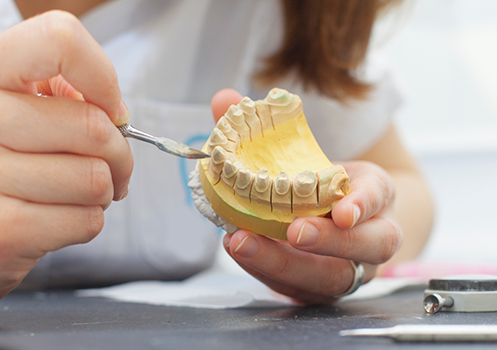Dental Bridges Conyers
Close Gaps & Restore the Function of Your Smile

Dental bridges are specially designed to close the gaps within the smile left by one or more missing teeth in a row. This trusted restorative treatment is both affordable and effective for patients who are looking to regain the function and appearance of their natural smile, making it an incredibly popular choice for patients impacted by tooth loss in Conyers. To learn whether a dental bridge is right for you, schedule a consultation with Dr. Peters today.
Why Choose Hillcrest Dentistry for Dental Bridges?
- Dental Care So Comfortable You’ll Doze Off
- Accepting Insurance & Offering Financing
- Local Dentist Who Loves Talking About College Football
What Is a Dental Bridge?

A dental bridge is an appliance specially designed to replace one or more missing teeth in a row. It consists of prosthetic teeth with dental crowns on each end. The missing teeth must be surrounded by natural healthy teeth or dental implants because a bridge relies on them as anchors to close the gap in between.
The Process of Getting a Dental Bridge

The process of getting a dental bridge is very similar to getting a dental crown, since bridges are anchored within the mouth by two crowns on either side. First, our team will prepare the teeth that will anchor your restoration within your mouth by removing a small amount of enamel and take impressions. Once we receive your final restoration back from our laboratory, we’ll make sure the restoration is a perfect fit and matches your surrounding teeth before permanently anchoring it in place.
Benefits of a Dental Bridge

As a popular tooth replacement option, dental bridges have many benefits, including the following:
- Preservation of the spacing in your bite.
- Longer-term solution than dentures.
- Added security and stability for prosthetic teeth.
- Lifelike appearance.
Dental Bridge FAQs
Do Dental Bridges Look Natural?
Our team will be sure to provide you with dental bridges that are constructed out of tooth-colored material, typically porcelain, so that your results can blend right into the rest of your smile. Dental porcelain is not only durable, but it can also mimic natural tooth enamel and can similarly reflect light. After your prosthetics have been placed, most people won’t even be able to tell the difference! While dentures rely on your gumline for support, your dental bridges will be anchored directly to your abutment teeth via dental cement, meaning you won’t have to worry about your prosthetic moving out of place or falling out.
What Can You Not Eat with a Dental Bridge?
Once you’ve received your dental bridge, you should be able to enjoy most of your favorite meals. However, it’s still important to be mindful of certain items. Sticky foods are usually the very things you’ll want to stay clear of, as they can sometimes loosen the prosthetic. For this reason, it’s a good idea to steer clear of treats like caramel, fruit gummies, and other sticky candies. Try to also minimize how often you consume sugary foods and drinks, as they can gradually introduce bacteria around and underneath your dental bridge.
How Long Should a Dental Bridge Last?
In most cases, a dental bridge should be able to last around 5 to 15 years. Of course, their lifespan will depend primarily on how well you take care of your smile. This can involve things like your oral hygiene, diet, and if you can refrain from bad oral habits, such as smoking, chewing on ice, grinding your teeth, and nail-biting. Dental bridges placed in the front of the smile will also typically last longer than those in the back of the mouth, as they won’t be subject to excessive pressure from chewing.
Is a Partial Denture the Same as a Dental Bridge?
No, partial dentures are not the same as a dental bridge. Some people might call them “removable bridges,” but this is incorrect. Partial dentures are designed to be removed by the patient at any time, whereas bridges are meant to remain in place indefinitely, or until your dentist removes or replaces them. Furthermore, partial dentures can be made to replace multiple missing teeth in various places in your mouth, while dental bridges are only designed to replace one to three consecutive missing teeth. Our team will be sure to discuss your options during your consultation so that we can determine the best option for you.
